Publications
Publications (Independent Research & Corresponding Author)
(undergraduate and graduate students underlined):
1) D. P. Ngan Le, M. Stollenz, S. Gozem*:
How Thermodynamic, Electronic, and Steric Factors Influence Mesitylcopper Oligomers
J. Phys. Chem. A 2025, 129, 10091−10100 [Link], published on 10/24/2025.
How Thermodynamic, Electronic, and Steric Factors Influence Mesitylcopper Oligomers
J. Phys. Chem. A 2025, 129, 10091−10100 [Link], published on 10/24/2025.
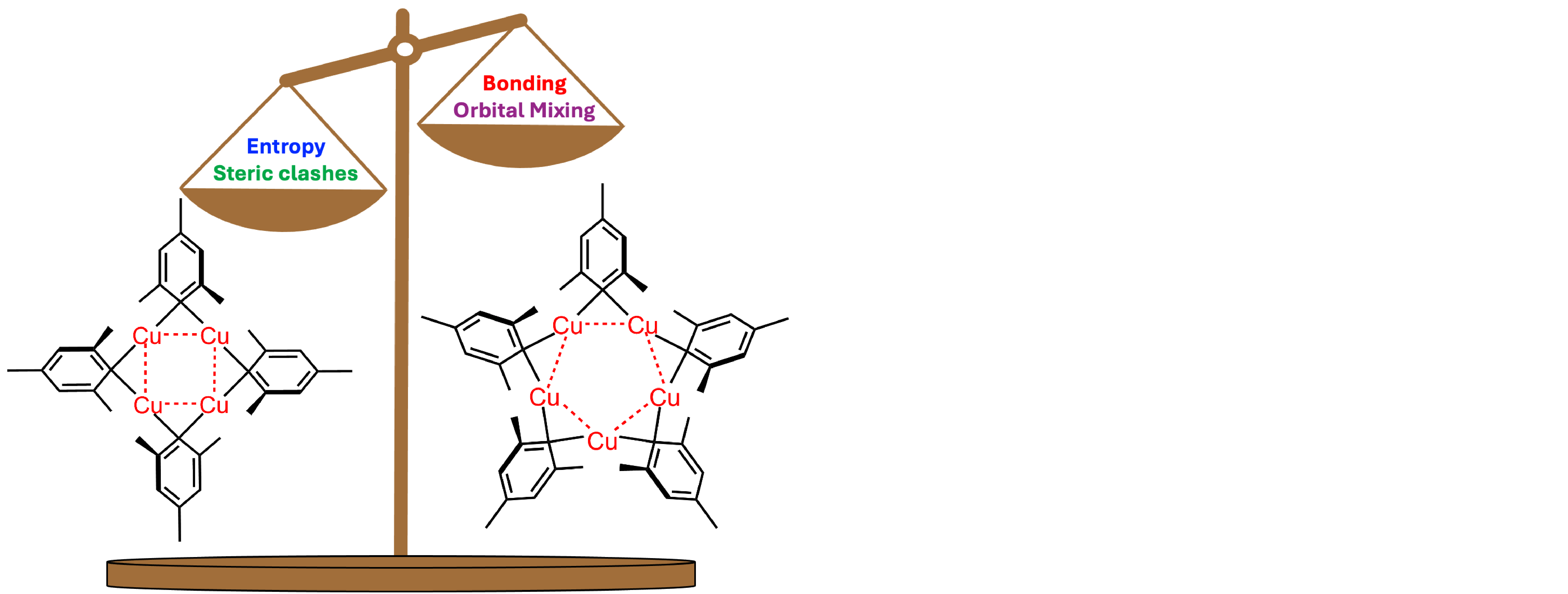
2) K. Dowling, T. Kruczyński, S. Dutta, D. P. Ngan Le, S. Gozem, C. D. McMillen, N. Bhuvanesh, M. Stollenz*:
Facile interconversion of mesitylcopper into a CuMes–Cu2bis(amidinate) triangle and a
tetracuprous Möbius strip
Chem. Commun. 2024, 60, 11136–11139 [Link], published on 09/16/2024.

3) J. Arras, A. Calderón-Diaz, S. Lebedkin, S. Gozem, C. D. McMillen, N. Bhuvanesh, M. Stollenz*:
Twisted and Disconnected Chains: Flexible Linear Tetracuprous Arrays and a Decanuclear
CuI Cluster as Blue- and Green/Yellow-Light Emitters
Inorg. Chem. 2024, 63, 12943–12957 [Link], published on 06/27/2024.
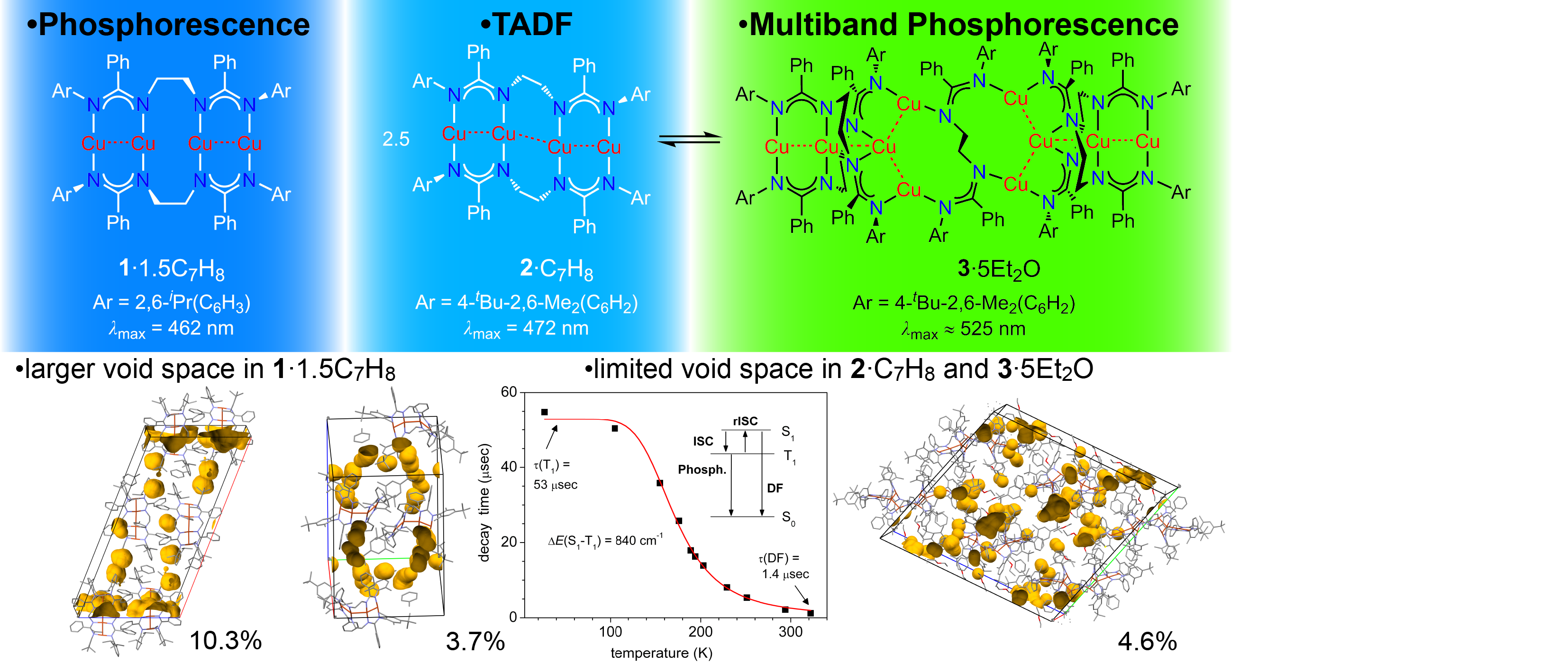
4) J. Arras, O. Ugarte Trejo, N. Bhuvanesh, C. D. McMillen, M. Stollenz*:
Hydrogen bonds and dispersion forces serving as molecular locks for tailored Group 11 bis(amidine) complexes
Hydrogen bonds and dispersion forces serving as molecular locks for tailored Group 11 bis(amidine) complexes
Invited Research Article
Inorg. Chem. Front. 2022, 9, 3267–3281 [Link], published on 05/13/2022.
Inorg. Chem. Front. 2022, 9, 3267–3281 [Link], published on 05/13/2022.
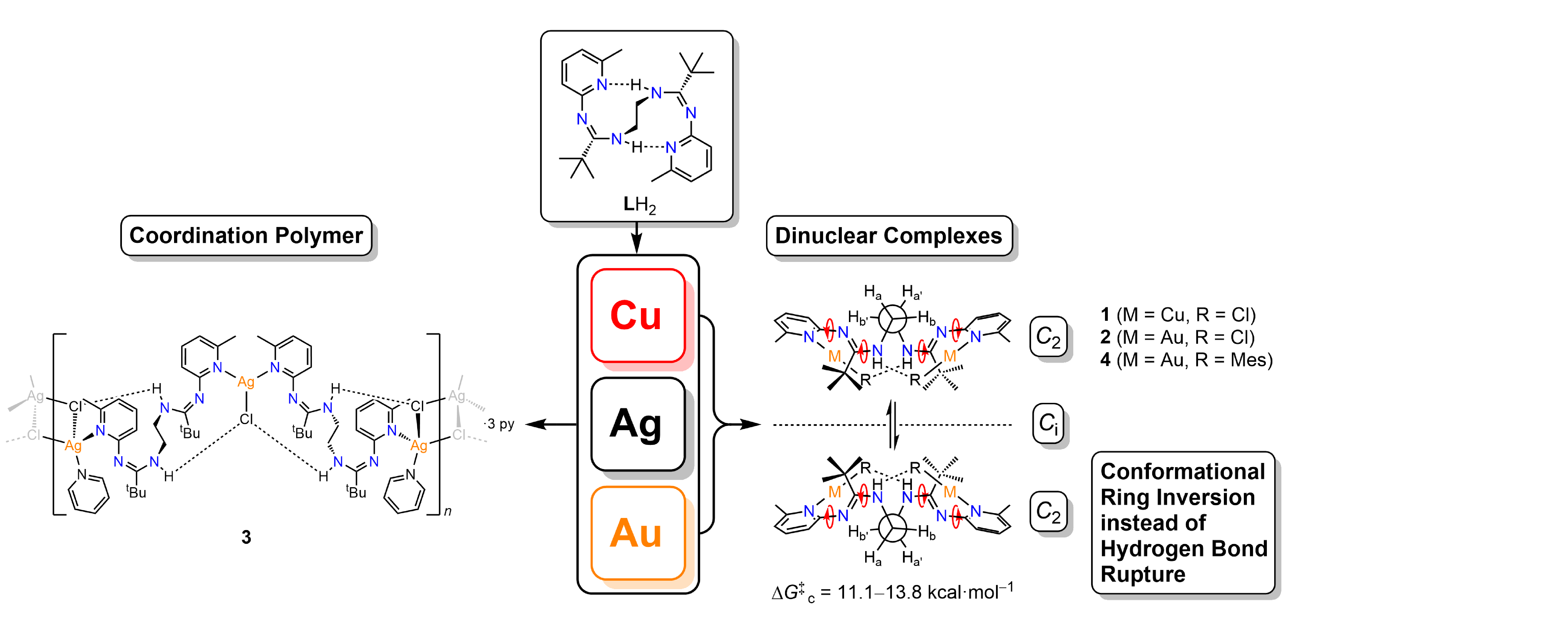
5) J. Arras, O. Ugarte Trejo, N. Bhuvanesh, M. Stollenz*:
Non‐conventional hydrogen bonding and dispersion forces that support embedding mesitylgold
into a tailored bis(amidine) framework
Chem. Commun. 2022, 58, 1418–1421 [Link], published on 12/20/2021.

6) A. Calderón‐Díaz, J. Arras, E. T. Miller, N. Bhuvanesh, C. D. McMillen, M. Stollenz*:
Ethylene‐Bridged Tetradentate Bis(amidines): Supramolecular Assemblies through Hydrogen Bonding and Photoluminescence upon Deprotonation
Eur. J. Org. Chem. 2020, 2020, 3243–3250 [Link].
Ethylene‐Bridged Tetradentate Bis(amidines): Supramolecular Assemblies through Hydrogen Bonding and Photoluminescence upon Deprotonation
Eur. J. Org. Chem. 2020, 2020, 3243–3250 [Link].

7) C. O’Dea, O. Ugarte Trejo, J. Arras, A. Ehnbom, N. Bhuvanesh, M. Stollenz*:
Ethylene-Bridged Hexadentate Bis(amidines) and Bis(amidinates) with Variable Binding
Sites
J. Org. Chem. 2019, 84, 14217–14226 [Link].
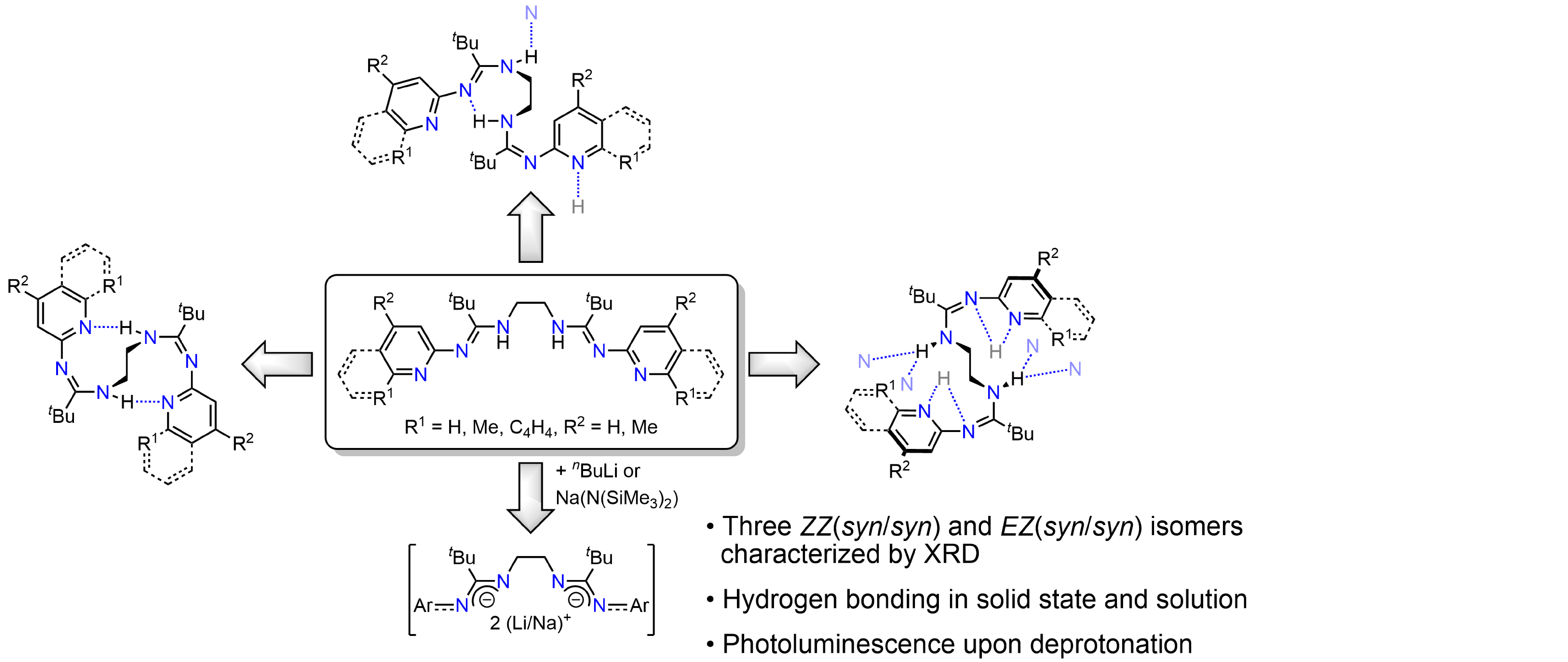
8) M. Stollenz*:
Linear Copper Complex Arrays as Versatile Molecular Strings: Syntheses, Structures,
Luminescence, and Magnetism
Invited review

9) M. Stollenz,* S. Fischer, H. Gehring, S. G. Resch, S. Dechert, C. Große, F. Meyer*:
Molecular Dicopper(I) Oxalate Stabilized by Two N-Heterocyclic Carbenes: A Potential Precursor for Copper Deposition
Invited contribution to “Multimetallic compounds – synthesis, characterization and
properties”,
a special issue dedicated to Prof. Heinrich Lang on the occasion of his 60th birthday
a special issue dedicated to Prof. Heinrich Lang on the occasion of his 60th birthday
J. Organomet. Chem. 2016, 821, 106–111 [Link].

10) M. Stollenz,* J. E. Raymond, L. M. Pérez, J. Wiederkehr, N. Bhuvanesh:
Highly Luminescent Linear Complex Arrays of up to Eight Cuprous Centers
Chem. Eur. J. 2016, 22, 2396–2405 [Link].

→This article was highlighted in Atlas of Science:
10a) M. Stollenz,* J. E. Raymond, L. M. Pérez, J. Wiederkehr, N. Bhuvanesh:
Luminescent molecular wires that consist of up to eight copper atoms
Atlas of Science, June 17, 2016 [Link].
11) M. Stollenz,* F. Meyer*:
Mesitylcopper–A Powerful Tool in Synthetic Chemistry
Invited contribution to the special issue “Copper Organometallic Chemistry”
Organometallics 2012, 31, 7708–7727 [Link].
Mesitylcopper–A Powerful Tool in Synthetic Chemistry
Invited contribution to the special issue “Copper Organometallic Chemistry”
Organometallics 2012, 31, 7708–7727 [Link].

12) M. Stollenz,* H. Gehring, V. Konstanzer, S. Fischer, S. Dechert, C. Große, F. Meyer*:
From Pyrazolate-Based Binuclear Copper(I) Complexes to Octanuclear σ-Mesityl-Bridged μ4-Oxo-Cuprocuprates: Controlled Dioxygen Splitting by Organocopper Scaffolds
Organometallics 2011, 30, 3708–3725 [Link] (& Front Cover Page, created by MS [Link]).
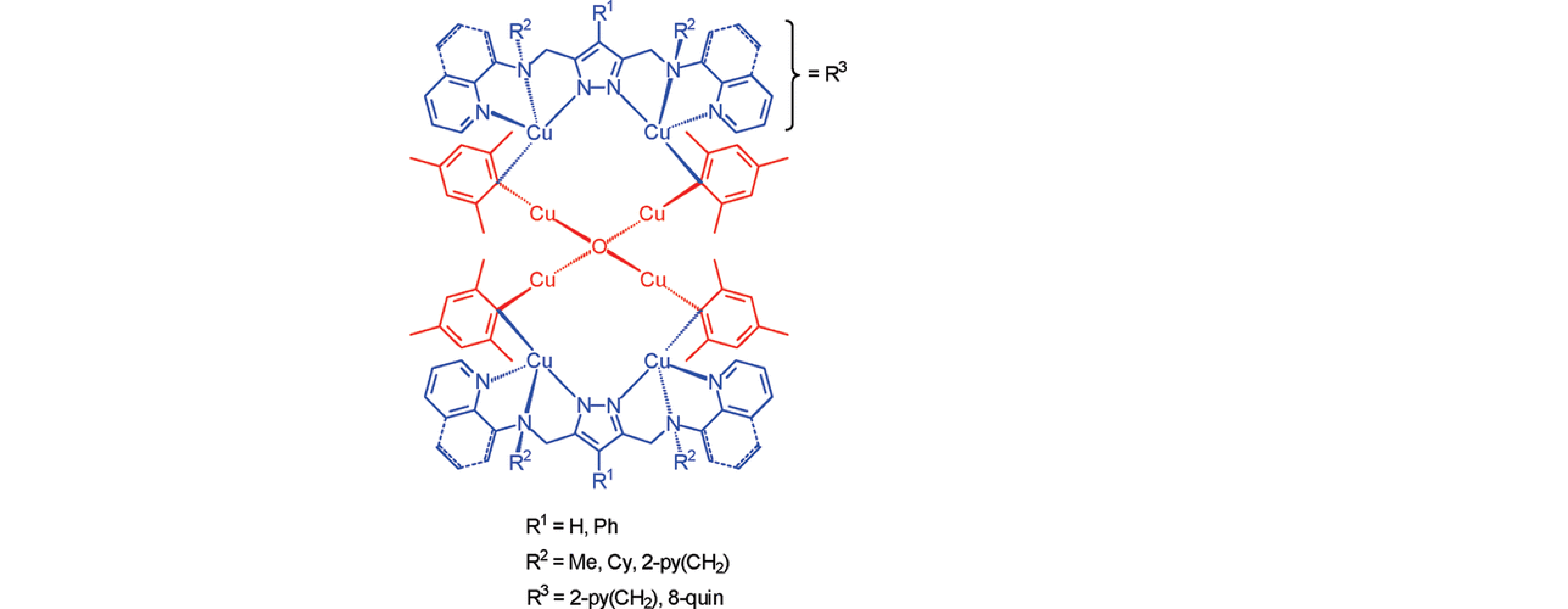
Publications (Postdoctoral Projects)
1) Y. Zhu, M. Stollenz, S. R. Zarcone, S. Kharel, H. Joshi, N. Bhuvanesh, J. H. Reibenspies, J. A. Gladysz*: Syntheses, homeomorphic and configurational isomerizations, and structures of macrocyclic
aliphatic dibridgehead diphosphines; molecules that turn themselves inside out
Chem. Sci. 2022, 13, 13368-13386 [Link].
Chem. Sci. 2022, 13, 13368-13386 [Link].

2) M. Stollenz, H. Joshi, A. Ehnbom, T. Fiedler, S. Kharel, J. H. Reibenspies, N. Bhuvanesh, M. B. Hall, J. A. Gladysz*:
Platinum complexes containing or derived from olefinic phosphines P(X)((CH2)6CH=CH2)2; ring closing metatheses, structures, and trans/cis isomerizations
Invited contribution, special issue dedicated to Prof. William D. Jones
Platinum complexes containing or derived from olefinic phosphines P(X)((CH2)6CH=CH2)2; ring closing metatheses, structures, and trans/cis isomerizations
Invited contribution, special issue dedicated to Prof. William D. Jones
Polyhedron 2019, 158, 325–333 [Link].
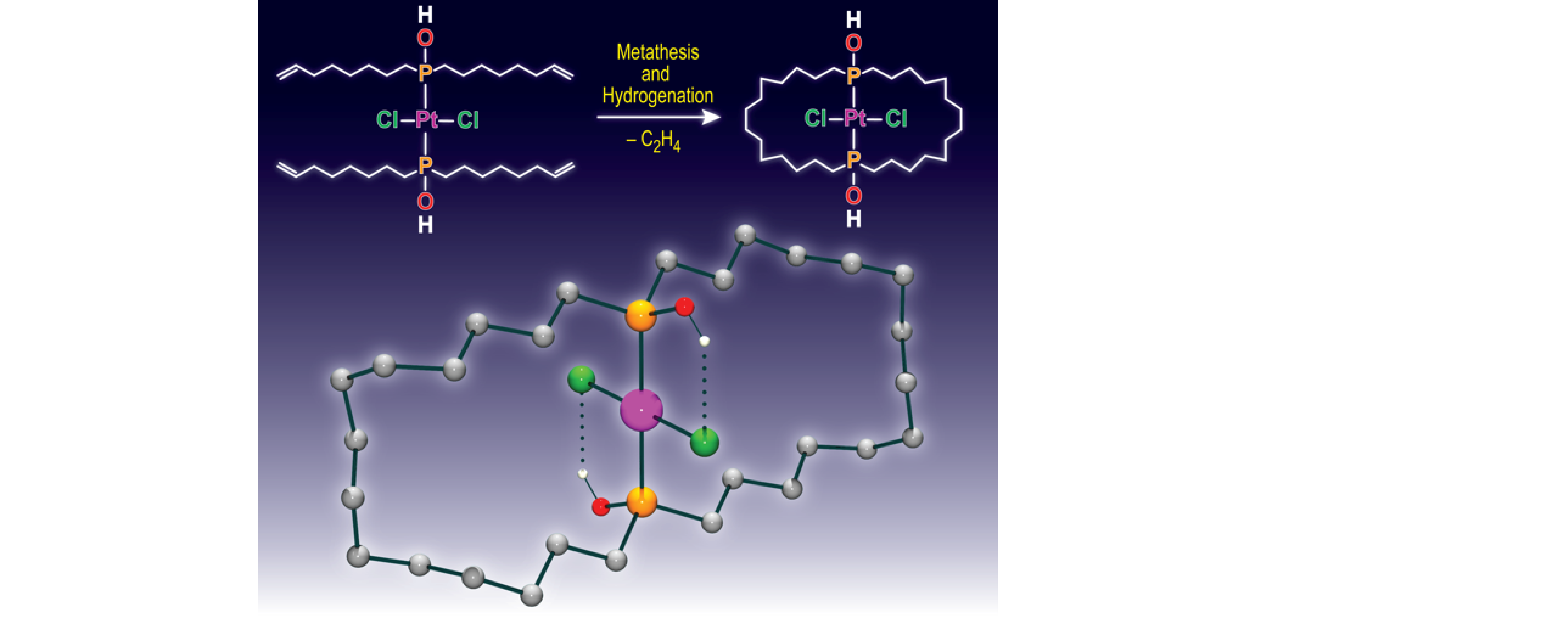
3) T. Fiedler, M. Barbasiewicz, M. Stollenz, J. A. Gladysz*:
Non-metal-templated approaches to bis(borane) derivatives of macrocyclic dibridgehead diphosphines via alkene metathesis
Non-metal-templated approaches to bis(borane) derivatives of macrocyclic dibridgehead diphosphines via alkene metathesis
Invited contribution, special issue “Progress in Metathesis Chemistry III”, edited
by Prof. Karol Grela
Beilstein J. Org. Chem. 2018, 14, 2354–2365 [Link].
4) S. Kharel, H. Joshi, S. Bierschenk, M. Stollenz, D. Taher, N. Bhuvanesh, J. A. Gladysz*:
Homeomorphic Isomerization as a Design Element for Container Molecules; Binding, Displacement, and Selective Transport of MCl2 Species (M = Pt, Pd, Ni)
J. Am. Chem. Soc. 2017, 139, 2172–2175 [Link].
Homeomorphic Isomerization as a Design Element for Container Molecules; Binding, Displacement, and Selective Transport of MCl2 Species (M = Pt, Pd, Ni)
J. Am. Chem. Soc. 2017, 139, 2172–2175 [Link].

5) M. Stollenz, D. Taher, N. Bhuvanesh, J. H. Reibenspies, Z. Baranová, J. A. Gladysz*:
Steric control of the in/out sense of bridgehead substituents in macrobicyclic compounds:
isolation of new “crossed chain” variants of in/out isomers
Chem. Commun. 2015, 51, 16053–16056 [Link].

6) A. J. Nawara-Hultzsch, M. Stollenz, M. Barbasiewicz, S. Szafert, T. Lis, F. Hampel, N. Bhuvanesh, J. A.
Gladysz*:
Gyroscope-Like Molecules Consisting of PdX2/PtX2 Rotators Within Three-Spoke Dibridgehead Diphoshine Stators: Syntheses, Substitution
Reactions, Structures, and Dynamic Properties
Chem. Eur. J. 2014, 20, 4617−4637 [Link].

7) M. Stollenz, N. Bhuvanesh, J. H. Reibenspies, J. A. Gladysz*:
Syntheses and Structures of Digold Complexes of Macrobicyclic Dibridgehead Diphosphines that Can Turn Themselves Inside-Out
Organometallics 2011, 30, 6510–6513 [Link].
Syntheses and Structures of Digold Complexes of Macrobicyclic Dibridgehead Diphosphines that Can Turn Themselves Inside-Out
Organometallics 2011, 30, 6510–6513 [Link].

8) M. Stollenz, M. Barbasiewicz, A. J. Nawara-Hultzsch, T. Fiedler, R. M. Laddusaw, N. Bhuvanesh, J. A. Gladysz*:
Dreifach-verbrückte Diphosphane mit von innen nach außen invertierender Konfiguration
Angew. Chem. 2011, 123, 6777–6781 (& Front Cover Page, created by MS).
Dibridgehead Diphosphines that Turn Themselves Inside Out

→This article was ranked as "Hot Paper" and highlighted both in C&En News and Science:
8a) S. K. Ritter:
Bicyclic Diphosphines Flip Inside Out,
Chem. & Eng. News 2011, 89, 33 [Link].
8b) J. Yeston:
Phosphorus Ins and Outs
Science 2011, 332, 1485 [Link].
9) M. Stollenz, M. John, H. Gehring, S. Dechert, C. Große, F. Meyer*:
Oligonuclear Homoleptic Copper(I) Pyrazolates with Multinucleating Ligand Scaffolds:
High Structural Diversity in Solid-State and Solution
Inorg. Chem. 2009, 48, 10049–10059 [Link].

10) M. Stollenz, F. Meyer:
Dicopper(I) Oxalate Complexes as Molecular Precursors for Copper Deposition
in Experiments in Green and Sustainable Chemistry, edited by H. W. Roesky
and D. K. Kennepohl, Wiley-VCH, Weinheim 2009, pp. 208–211[Link] .
Dicopper(I) Oxalate Complexes as Molecular Precursors for Copper Deposition
in Experiments in Green and Sustainable Chemistry, edited by H. W. Roesky
and D. K. Kennepohl, Wiley-VCH, Weinheim 2009, pp. 208–211[Link] .
11) M. Stollenz, C. Große, F. Meyer*:
An unusually stable octanuclear σ-mesityl-bridged µ4-oxo-copper(I) complex encapsulated by a pyrazolate-based compartmental ligand scaffold
Chem. Commun. 2008, 1744–1746 [Link].

12) M. Stollenz, F. Meyer:
1.) “Addition of Arenes to Ethylene and Propene Catalyzed by Ruthenium; 2.) Comparative Reactivity of TpRu(L)(NCMe)Ph (L = CO or PMe3): Impact of Ancillary Ligand L on Activation of Carbon–Hydrogen Bonds Including Catalytic Hydroarylation and Hydrovinylation/Oligomerization of Ethylene”
by M. Lail, B. N. Arrowood, N. A. Foley, J. P. Lee, T. B. Gunnoe, T. R. Cundari, J. L. Petersen
1.) “Addition of Arenes to Ethylene and Propene Catalyzed by Ruthenium; 2.) Comparative Reactivity of TpRu(L)(NCMe)Ph (L = CO or PMe3): Impact of Ancillary Ligand L on Activation of Carbon–Hydrogen Bonds Including Catalytic Hydroarylation and Hydrovinylation/Oligomerization of Ethylene”
by M. Lail, B. N. Arrowood, N. A. Foley, J. P. Lee, T. B. Gunnoe, T. R. Cundari, J. L. Petersen
Review
Chemtracts 2007, 20, 371–378.
Chemtracts 2007, 20, 371–378.
13) M. Stollenz, F. Meyer:
“Concepts and Models in Bioinorganic Chemistry” edited by H.-B. Kraatz and N. Metzler-Nolte, Wiley-VCH, Weinheim 2006, 1. Ed., Text Book, XXVI + 443 pages, ISBN 3-527-31305-2
Book review
“Concepts and Models in Bioinorganic Chemistry” edited by H.-B. Kraatz and N. Metzler-Nolte, Wiley-VCH, Weinheim 2006, 1. Ed., Text Book, XXVI + 443 pages, ISBN 3-527-31305-2
Book review
Chem. Unserer Zeit 2007, 6 (Treffpunkt Buch plus), IV–V [Link].
Publications (Graduate Projects)
1) M. Stollenz, D. Walther,* L. Böttcher, H. Görls:
Complexes of Nickel(II) with Oxalic Amidines and Oxalic Amidinates with Additonal
R2P-Donor Groups
Z. Anorg. Allg. Chem. 2004, 630, 2701–2708 [Link].

2) M. Stollenz, M. Rudolph, H. Görls, D. Walther*:
Nickel(II) complexes of the type [RM(oxam)MR] (oxam: oxalamidinate, R = n-butyl, n-hexyl):
the first binuclear n-alkyl nickel complexes
J. Organomet. Chem. 2003, 687, 153–160 [Link].

3) K. Lamm, M. Stollenz, M. Meier, H. Görls, D. Walther*:
Binuclear oxalamidinate complexes (MePd)2(oxam) and homoleptic complexes of the type
[(THF)nLi4(Me8)M2], and [(THF)4Li2(Ph4)M] (M: Pd, Ni): synthesis, structures and catalytic C-C linking reactions
J. Organomet. Chem. 2003, 681, 24–36 [Link].

4) S. Rau, L. Böttcher, S. Schebesta, M. Stollenz, H. Görls, D. Walther*:
Simultaneous Cation-/Anion Coordination by Bifunctional 1,2-Diimine-/1,2-Diamine Type
Ligands: Synthesis, Structures and Properties of Zwitterionic Ruthenium and Iron Complexes
Eur. J. Inorg. Chem. 2002, 2800–2809 [Link].
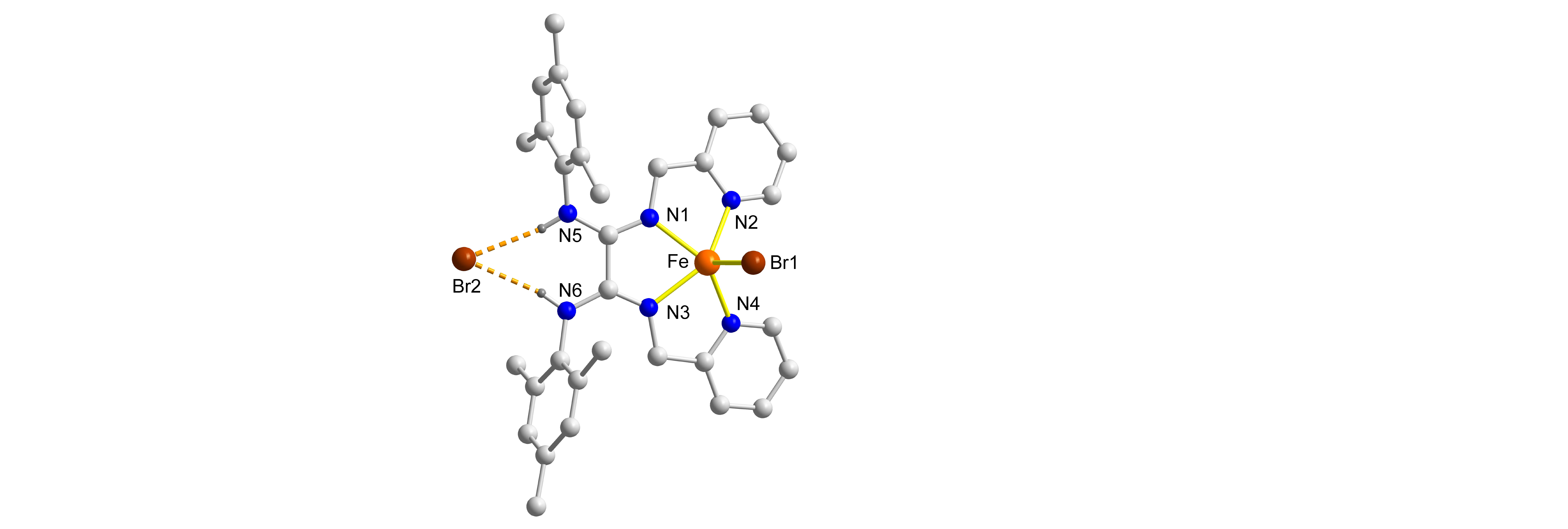
5) D. Walther,* M. Stollenz, H. Görls:
Dinuclear [RNi(oxam)NiR] Complexes (oxam = N1,N2-bis(2-pyridylmethyl)-N3,N4-bis(2,4,6-trimethylphenyl)-oxalamidinate; R = Me, Ph, C≡CH, C≡CPh): Reactions of
the Methyl Complex and Formation of [Li(THF)]2Li2Ni2Me8 and [Li(THF)]4Ni2Me8
Organometallics 2001, 20, 4221–4229 [Link].

6) D. Walther,* M. Stollenz, L. Böttcher, H. Görls:
Binuclear Nickel(II) Complexes with Oxalamidinates as Bridging Ligands: Synthesis
and Structures of Compounds with Planar, Tetrahedral, Tetragonal-pyramidal, and Octahedral
Coordination
Z. Anorg. Allg. Chem. 2001, 627, 1560–1570 [Link].

Last update: 12/14/2025









